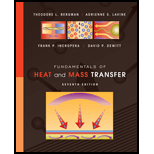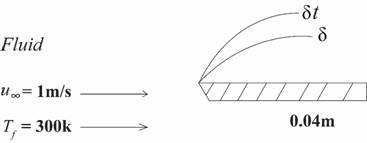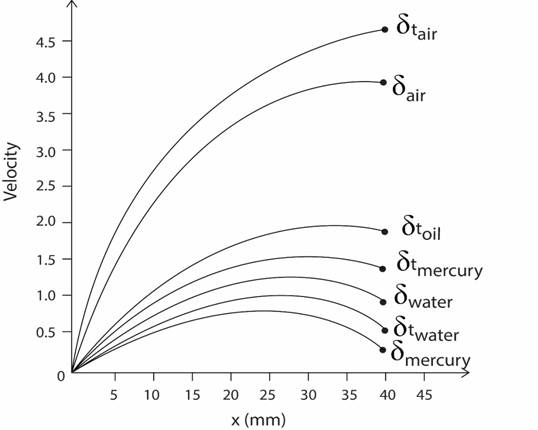
Consider the following fluids at a film temperature of 300 K in parallel flow over a flat plate with velocity of 1 m/s: atmospheric air, water, engine oil, and mercury.
- For each fluid, determine the velocity and thermal boundary layer thicknesses at a distance of 40 mm from the leading edge.
- For each of the prescribed fluids and on the same coordinates, plot the boundary layer thicknesses as a function of distance from the leading edge to a plate length of 40 mm.
(a)
The velocity and thermal boundary layer thickness at a distance of
Answer to Problem 7.1P
The thermal boundary layer thickness for air, water, oil and mercury is 4.48, 0.52, 1.27, and 1.17 respectively.
Explanation of Solution
Given Information:
Properties of air at
Properties of water at
Properties of engine oil at
Properties of mercury at
Concept used:
The equation of Reynolds number is
The formula for nusselt number is
The formula for average nusselt number is
The formula of laminar
Nusselt number:
It is the ratio of convective heat transfer to convective heat transfer across a boundary.
Where
Calculation:
Know that the equation of Reynolds number.
From the figure:

Put
Put
Know that the formula of laminar
Put
Convert the unit of laminar
Know that the formula of laminar
Put
Put
Know that the formula of laminar
Put
Know that the formula of laminar
Put
Put
Know that the formula of laminar
Put
Know that the formula of laminar
Put
Put
Know that the formula of laminar
Put
Know that the formula of laminar
Put
Conclusion:
Hence, the thermal boundary layer thickness for air, water, oil and mercury is 4.48, 0.52, 1.27, and 1.17 respectively.
b)
To draw: the boundary layer thickness from the leading edge to a plate length of
Answer to Problem 7.1P
Created the graph for determined values of thermal boundary layer thickness for air, water, oil and mercury is 4.48, 0.52, 1.27, and 1.17 respectively with the values oflaminar thermal boundary layer
Explanation of Solution
Given Information:
The thermal boundary layer thickness for air, water, oil and mercury is 4.48, 0.52, 1.27, and 1.17 respectively.
Entire length
Boundary layer
Concept used:
Plot the graph by Matlab software, obtained values by formulas correlation between Reynolds equation, Nusselt number, average nusselt number and boundary layer thickness.
Calculation:
Know that the determined values of thermal boundary layer thickness for air, water, oil, mercury are 4.48, 0.52, 1.27, and 1.17 respectively and determined values of the laminar thermal boundary layer are
Substitute the values of thermal boundary layer thickness and laminar thermal boundary on the graph.

Conclusion:
Created the graph for determined values of thermal boundary layer thickness for air, water, oil and mercury is 4.48, 0.52, 1.27, and 1.17 respectively with the values oflaminar thermal boundary layer
Want to see more full solutions like this?
Chapter 7 Solutions
Fundamentals of Heat and Mass Transfer
- 5.7 The average Reynolds number for air passing in turbulent flow over a 2-m-long, flat plate is . Under these conditions, the average Nusselt number was found to be equal to 4150. Determine the average heat transfer coefficient for an oil having thermal properties similar to those in Appendix 2, Table 18, at at the same Reynolds number and flowing over the same plate.arrow_forward5.43 A refrigeration truck is traveling at 130 km/h on a desert highway where the air temperature is . The body of the truck is idealized as a rectangular box 3 m wide, 2.1 m high, and 6 m long, at a surface temperature . Assume that (1) the heat transfer from the front and back of the truck is neglected, (2) the stream does not separate from the surface, and (3) the boundary layer is turbulent over the whole surface. Calculate the required cooling rate of the refrigeration unit.arrow_forwardOil flow in a journal bearing can be treated as parallel flow between two large isothermal plates with one plate moving at a constant velocity of 8 m/s and the other stationary. Consider such a flow with a uniform spacing of 0.7 mm between the plates. The temperatures of the upper and lower plates are 40°C and 15°C, respectively. By simplifying and solving the continuity, momentum, and energy equations, determine (a) the velocity and temperature distributions in the oil, (b) the maximum temperature and where it occurs, and (c) the heat flux from the oil to each plate.arrow_forward
- Air at 1 atm with a velocity of 4 m/s and a temperature of 50oC flows over a flat plate that is at a uniform temperature of 100oC. The plate has a length of 0.20 m and a width of 0.1 m. a) What is the average heat transfer coefficient? b) What is the heat transfer rate from plate to the air? c)What is the average friction coefficient and the drag force ? d)What is the heat transfer coefficient at x=0.15 m ?arrow_forwardConsider a flat plate placed inside a wind tunnel, and air at 1 ATM and 20°C is flowing with a free flow velocity of 60 m/s. What is the minimum length of the plate needed for the Reynolds number to reach 2 × 107? If the critical Reynolds number for external flow is 5 × 105, what type of flow regime would the airflow experience at 0.2 m from the leading edge? I need the solution from fundamental concepts of how the heat flow behaves in the systemarrow_forwardFUNDAMENTALS OF CONVECTION Consider a flat plate positioned inside a wind tunnel, and air at 1 atm and 20°C is flowing with a free stream velocity of 60 m/s. What is the minimum length of the plate necessary for the Reynolds number to reach 2x107? If the critical Reynolds number is 5x105, what type of flow regime would the airflow experience at 0.2 m from the leading edge? Please, I need the solution from fundamental concepts of how the heat flow behaves in the system. That it be answered with theory of the subjectarrow_forward
- A coated sheet is being dried with hot air blowing in cross flow on the sheet surface. The surface temperature of the sheet is constant at 90°C, while the air velocity and temperature are 0.3 m/s and 110°C, respectively. The length of the sheet subjected to the blowing hot air is 1 m long. Determine the convection heat transfer coefficient and the heat flux added to the sheet surface. Treat the coated sheet as a vertical plate in cross flow.arrow_forwardAir at atmospheric pressure and a temperature of 25 degrees C is in parallel flow at a velocity of 5 m/s over a 1-m-long flat plate that is heated from below with a uniform heat flux of 1250 W/m2 . Assume the flow is fully turbulent over the length of the plate. Take ν = 18.76 × 10−6 m2/s, k = 0.0284 W/m·K and Pr =0.703. (a) Calculate the plate surface temperature, Ts(L), and the local convection coefficient, hx(L), at the trailing edge, x = L. (b) Calculate the average temperature of the plate surface.arrow_forwardA steel plate has dimensions of 3 m by 1 m and is initially kept at a temperature of 30 degree Celsius. It is cooled by blowing air parallel to the 1 m edge at 9 km/hr. The temperature of the flowing air is maintained at 10 degree Celsius. Estimate the convection heat transfer rate from both sides of the plate.arrow_forward
- Engine oil at 100°C and a velocity of 0.1 m/s flows over both surfaces of a 1.2-m-long flat plate maintained at 20°C.Determine:(a) The velocity and thermal boundary layer thicknesses at the trailing edge.(b) The local heat flux and surface shear stress at the trailing edge.(c) The total drag force and heat transfer per unit width of the plate.arrow_forwardThe flow velocity of air over a flat plate of dimension 1160 ×610 ×25 mm at 30 OC is 3.2 m/s. The top surface of the plate is maintained at 110 OC. Calculate the bottom temperature of the plate at steady state.arrow_forwardAir at a pressure of 1/10 atm and 276 K flows with a free flow velocity of 700 m/s along a flat plate 1.25 m long. If the plate surface temperature must be maintained at 325 K: a) Calculate the cooling rate required for each meter of plate width. b) Repeat calculations for air pressures of 1/15 and 1/25 atm. c) Give a discussion for this case.arrow_forward
 Principles of Heat Transfer (Activate Learning wi...Mechanical EngineeringISBN:9781305387102Author:Kreith, Frank; Manglik, Raj M.Publisher:Cengage Learning
Principles of Heat Transfer (Activate Learning wi...Mechanical EngineeringISBN:9781305387102Author:Kreith, Frank; Manglik, Raj M.Publisher:Cengage Learning
